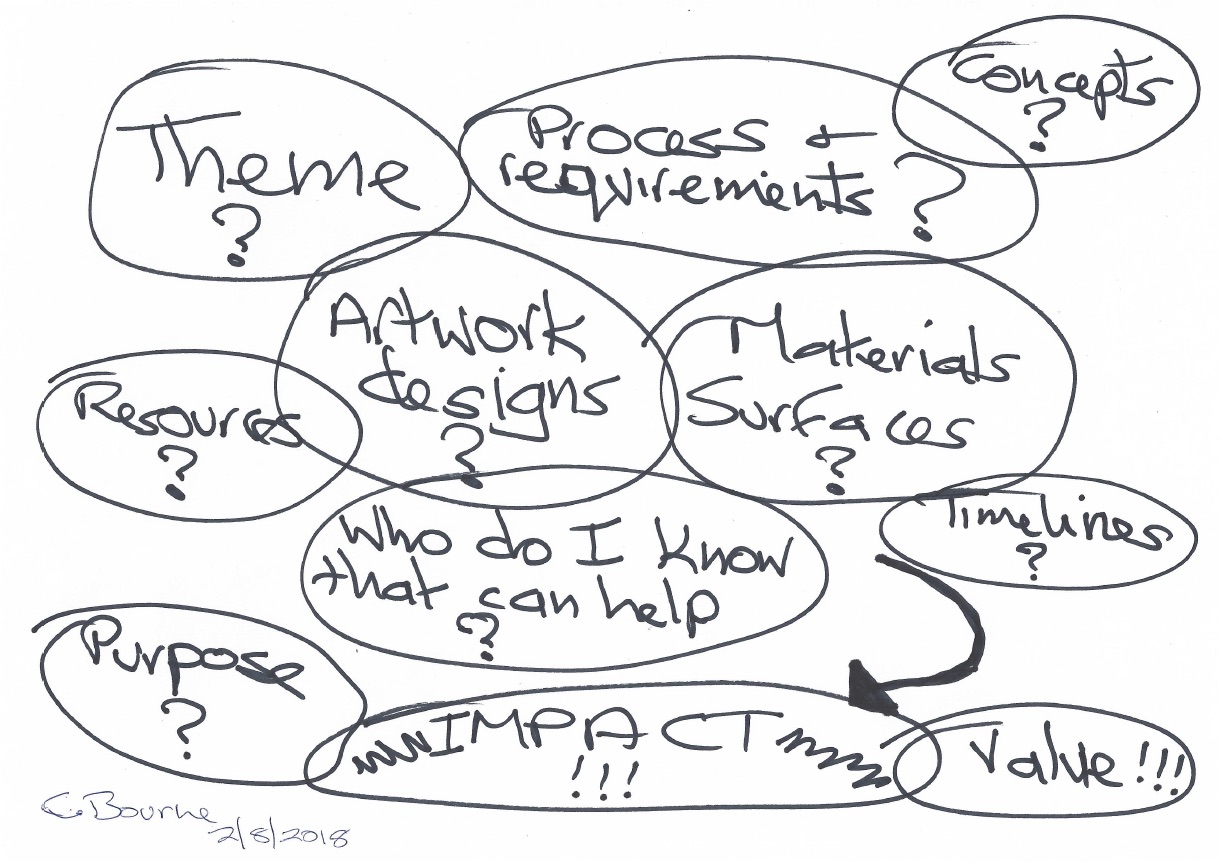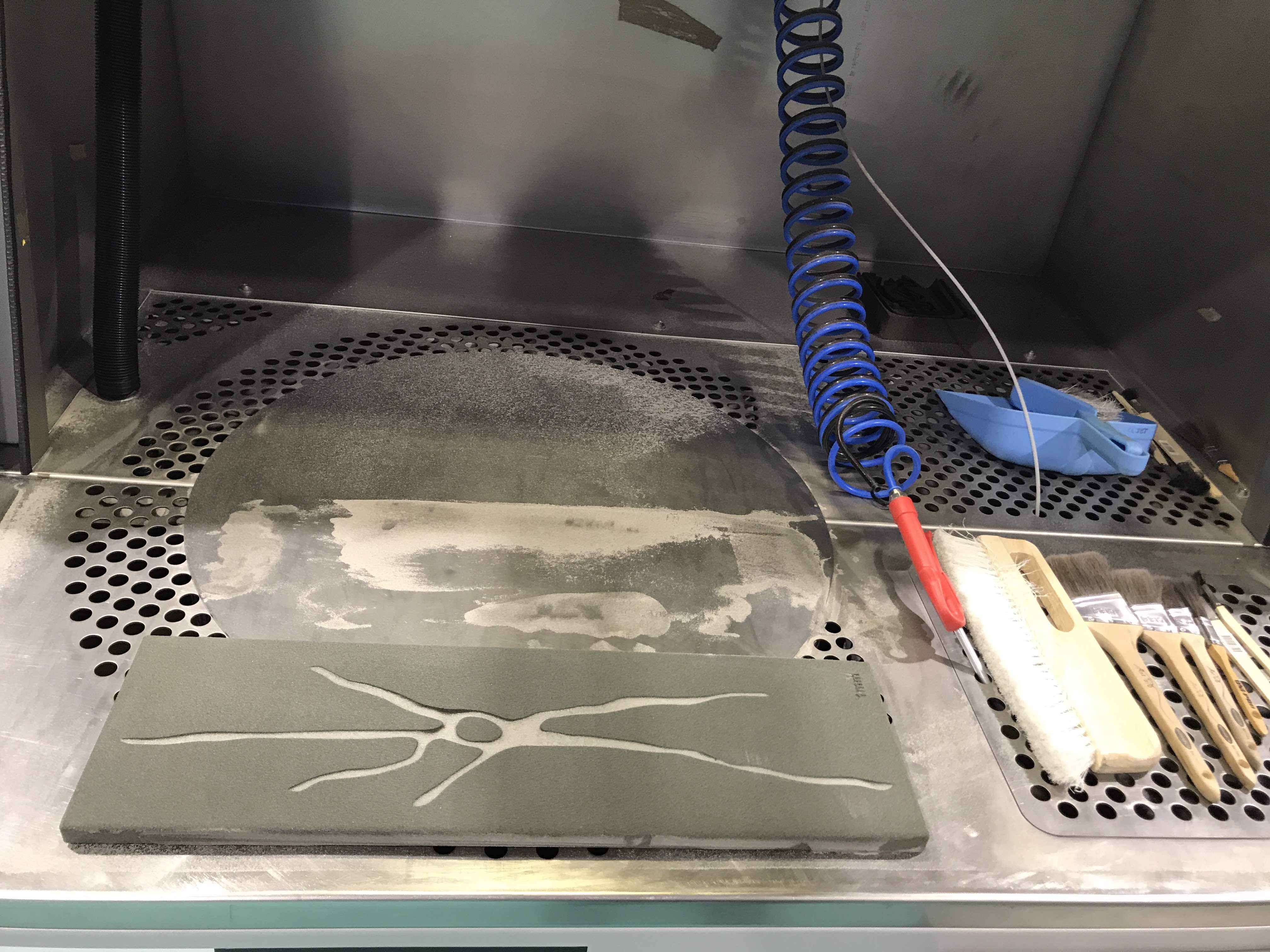About ‘me’
Based on my experience over more than two decades, I have gained understanding of the nature and scope of, ‘being human’. My perspectives and capabilities are as a humanist, entrepreneur and thought leader.
I draw upon my experience, qualifications research, writing, medical laboratory science, technology, business, multidisciplinary design, archaeology and psychology in an holistic approach to meet human needs, wants and desires and, in the process, use alternative thinking to determine new ways of thinking, new ways of working to create practical and achievable solutions for the betterment of humankind.
Purpose and Meaning
Around us we see here and there beauty in waterfalls, sunsets, the bobbing heads of poppies, savour a decadent dessert through our senses, look into the eyes of a loved one, gaze on magnificence at the Uffizzi, but inside us – we are even more beautiful and we don’t know it.
My artwork designs seek to reveal the essence of ‘being human’ – regardless of age, health, nationality, gender, religion or socio-economic status.
We are the same, yet miraculously different – ‘Connectiveness’.
Opportunity Arises
Emails, more emails.
On Wednesday 1 August 2018 at 17:28 a ‘Reminder: Applications open for ANAT’s Synapse CSIRO Residency Program’ arrives. It states, ‘ANAT and CSIRO have identified three research areas that we believe have the right mix of compelling science and researchers committed to working with artists and providing the necessary level of support’.
One of the three areas held my interest 3D printing (metals), an area in which I have prior knowledge. I have researched the technology, visited facilities and consulted with key individuals particularly in regard to Manufacturing Industries. Also prior to this I was extremely interested in stereolithography, a technology out of which 3D metal printing arose (I initiated the setup of ‘The Polymer Centre’ at RMIT – VIPAC planned to relocate their stereolithography equipment to their Singapore offices – Bourne negotiated selling the stereolithography equipment to RMIT).
Marker and Paper
A ‘Thought Map’ was created to visually explore considerations as to proceeding.
> Questions abounded in regard to the Agreement, and the undertaking of the Residency.
> Rang Vicki Sowry, ANAT and spoke to her.
> Rang Dr Daniel East, CSIRO and spoke to him.
> Theme – builds on concepts and work done previously and is a recurring theme of my work, therein to gain leverage from my existing, recurring theme ie beauty and knowing what it is to ‘being human’. Knowing what constitutes our physicality – our bodies and how we work at a cellular level.
> Cells. It is also about knowing what is inside us that, in this instance, makes our brains work in wellness and ill health ie Alzheimer’s Disease, dementia.
> Source and use reference material to inspire the artwork designs, but is not a literal translation.
> Draw upon my medical laboratory experience re light and electron microscope photographs.
> Draw upon my design perspectives and experience here and overseas including conversations such as with Alberto Alessi, Alessandro Medini, Milan, Arturo Dell’Acqua Bellavitis to name a few. My definition of ‘Design is problem solving to meet human needs, wants and desires’.
> Draw upon my knowledge and experience – research+medical laboratory science+technology+art+design.
> What about current technologies photographing neurons?
> What about CAD?
> Decision. Feasible. Proceed.
An ‘Artwork Designs Map’ was generated to explore options.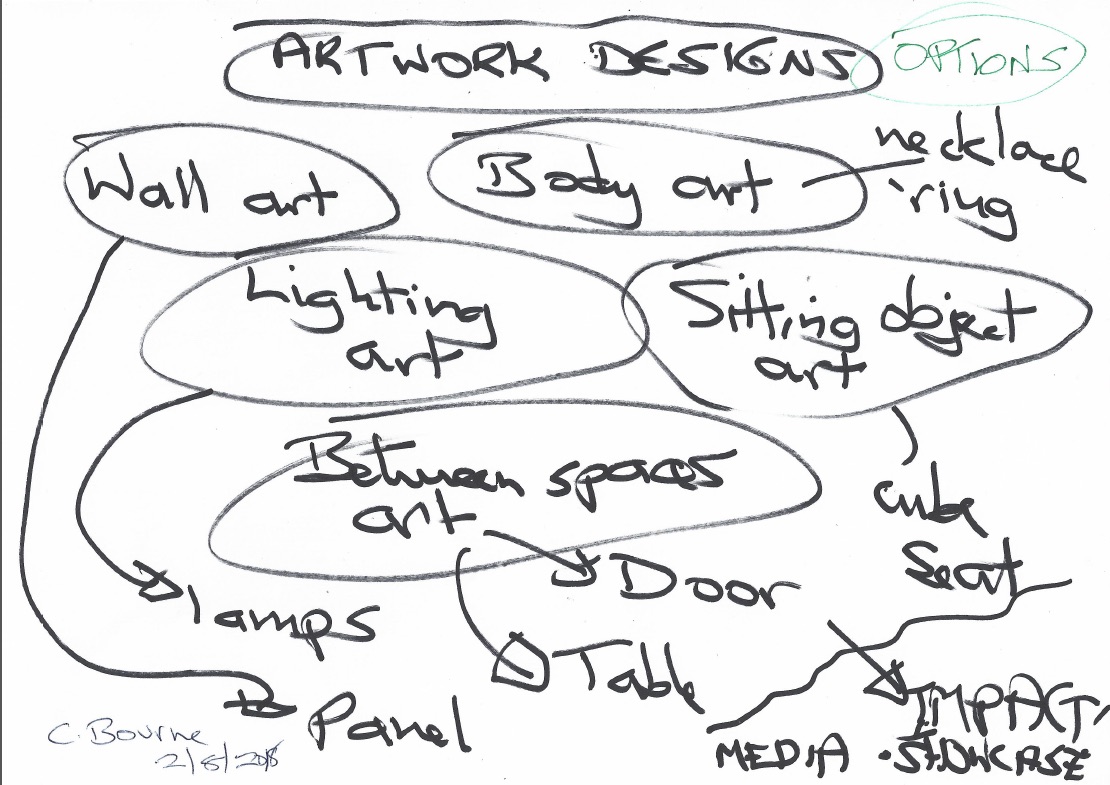
Who do I know that can Help?
RELATIONSHIP BUILDING • CONTEXT
CAD
My primary computer knowledge/skills are in two-dimensional work, whereas this project requires three-dimensional CAD capabilities.
I contacted Mark Strachan a long time industrial design colleague and friend at Swinburne University, School of Design, who put me in touch with an Honours student who has just completed an internship with the CSIRO – accordingly, he is familiar with the people and technologies. Hasitha Bandara is totally supportive of my theme, ideas, concepts and reasons for undertaking the project. He has enthusiastically offered to do all my CAD work and I have commited to teach/mentor him re “being a designer” plus developing a basic Business Plan for his use.
NEURONS
Professor Ashley Bush immediately comes to mind.
Context
In 2006, I arranged a consultation with Ashley with my mother accompanying me; she had Alzheimer’s Disease which was rapidly progressing. His research/approach/treatment not only halted the progress of her disease, it actually resulted in her retrieving some memory. My beloved mother has now passed away, nonetheless, my relationship with Ashley continues – his scientific endeavours and has evolved into a highly valued friendship. He is Chief Scientific Officer for the Cooperative Research Centre for Mental Health (Parkville); Professor of Neuroscience and Psychiatry at the University of Melbourne and holds several other eminent positions. Professor Bush is one of the most highly cited neuroscientists in Australia and is rated in the top 1% of neuroscience researchers worldwide for high impact citations, and classed as one of the World’s Most Influential Scientific Minds. (Thomson Reuters)
I ring him. Over drinks he tells me of his work as Director of the new ‘Melbourne Dementia Research Centre’ (MDRC) which is a joint collaboration between the University of Melbourne and The Florey Institute of Neuroscience and Mental Health. It has a charter to transform research in dementia.
I raise the project and my theme with him – ‘Connectiveness: Macro to Micro. Transforming the micro of human anatomy to the visible macro world’ with the artwork design forms being inspired from the brain and neurons and micro-organelles.
I asked, could he, would he provide photographs copyright free within 36 hours as the deadline for the submission loomed.
Ashley’s response, ‘Yes’. Stunning images arrived. A few images are seen in the extracts below.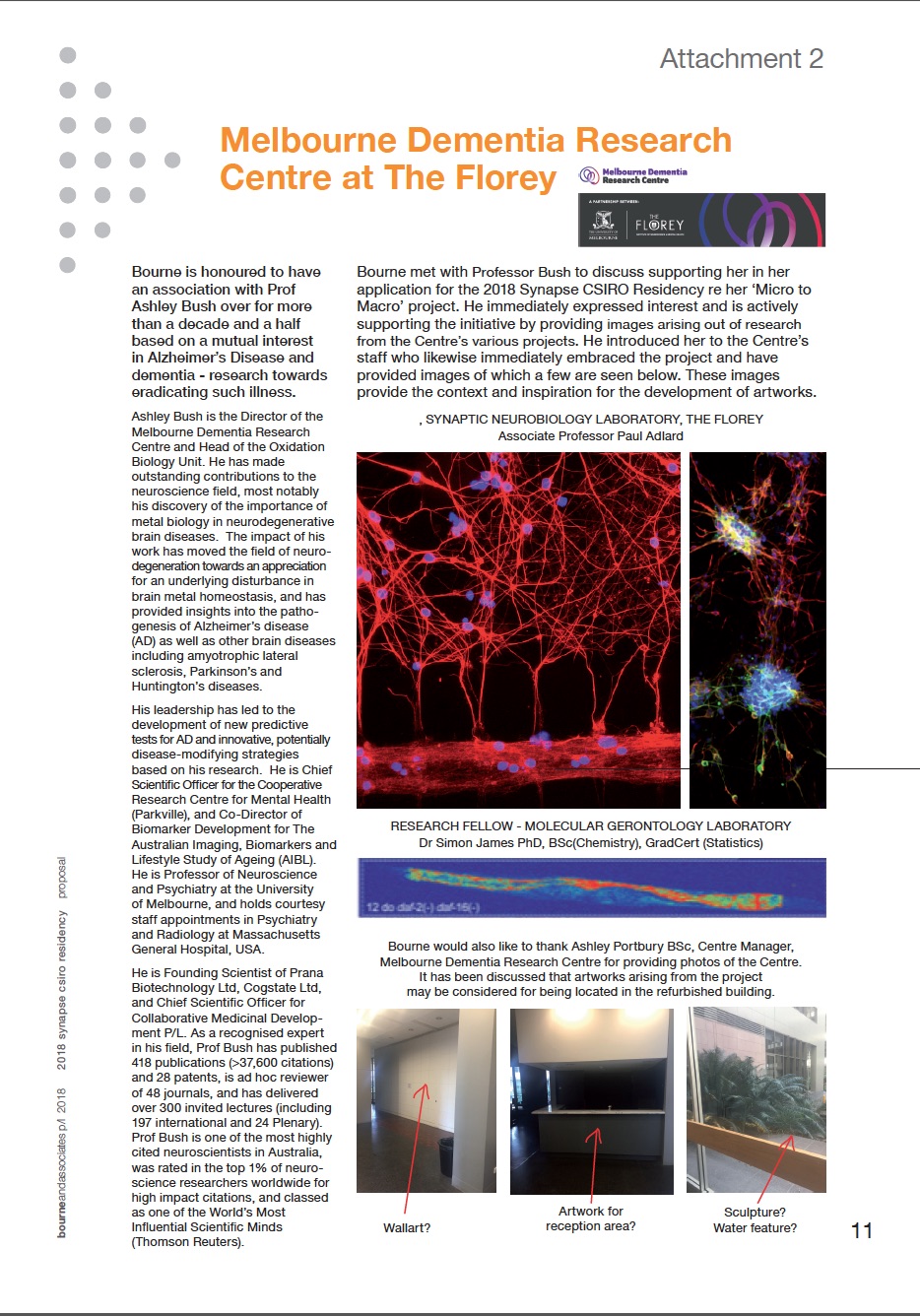
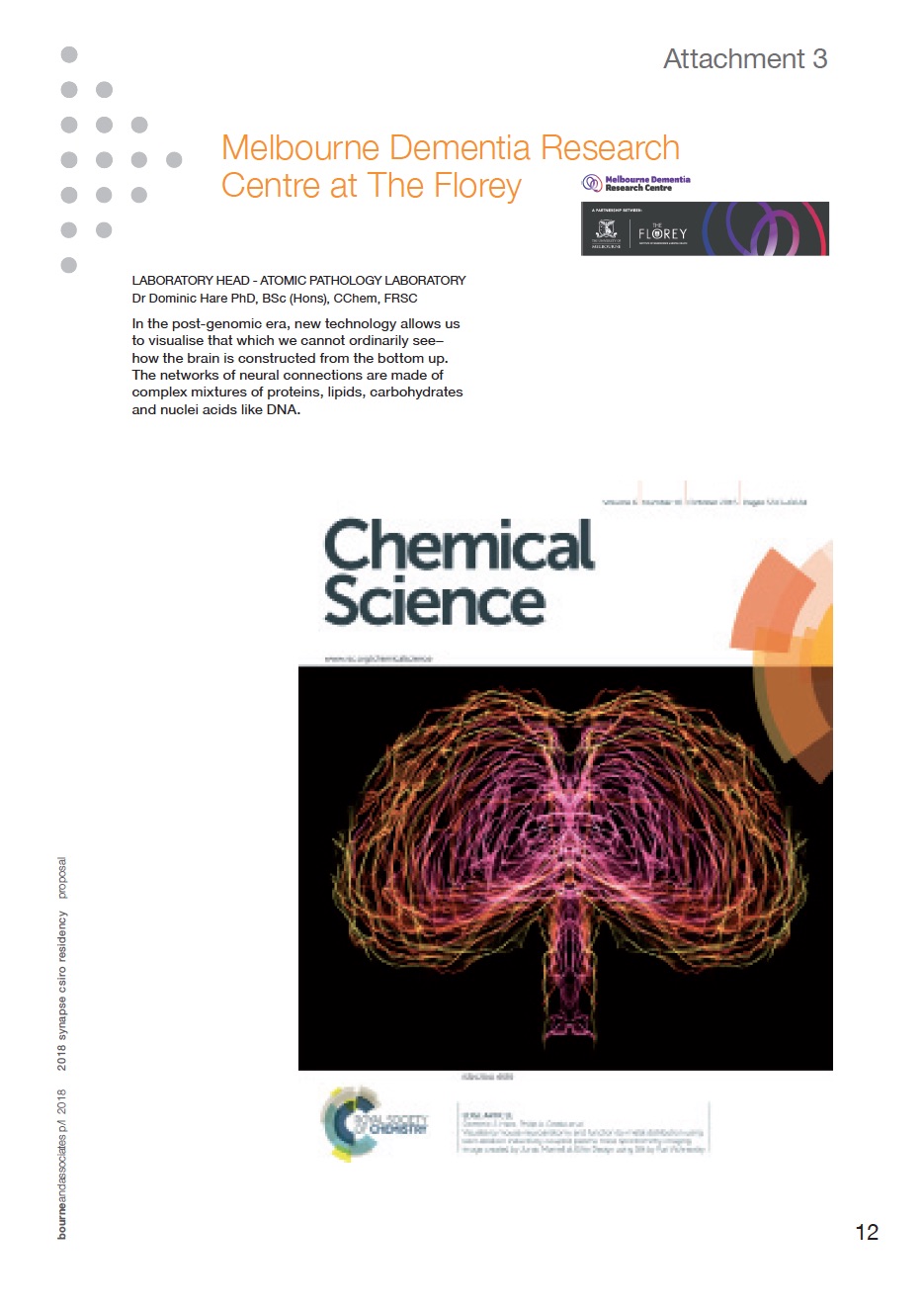
Extracts: From Bourne’s ‘ANAT’s 2018 Synapse CSIRO Residency Program’ application.
Getting It In • The Response
Wrote the application. Submitted.
On 23 August 2018 at 17:12 I received an email:
Dear Carolynne
Thank you for applying to the 2018 Synapse CSIRO Residency program.
The selection panel has met to consider the applications and I am writing to let you know that your application was successful. Congratulations!
Program commences 24 September 2018
Taking Vicki’s advice, I do not even begin to think of the artwork designs until I have advice as to the outcome of my application then to visit Lab 22 to observe the 3D printers/casting and what they can produce ie metals, size, finishes and so forth. This I do.
Not able to meet with Dr Daniel East, the Residency began with data sheets being emailed to me that listed the 3D metal printing and casting equipment. A meeting with Dr Darren Fraser, Lab 22 Arcam, Senior Experimental Scientist, Deposition and Additive Structures Team, Arcam, Metal Industries Program, CSIRO Manufacturing and Andrew Urban, Senior Project Scientist at CSIRO. Cold Spray Equipment Leader. Additive Manufacturing was arranged.
Darren and Andrew outlined the information emailed by Daniel and I presented an overview of my theme and how I planned to approach the Residency.
The Plan
OBJECTIVE
To learn to the fullest extent over the 12 week timeframe about 3D printing/casting processes available in Lab 22 and applying that learning to a range of artwork designs.
STRATEGY
Generating multiple concepts from a wide range of photographs would require significant time and, in turn, generating CAD drawings from those concepts was likewise time consuming. Therein, with the objective in mind, time was a critical determinant.
The Strategic Decision was to restrict the scope of concepts into two areas drawing from my photographic collection and what I had received from the MDRC:
- Neuron Series
Select one reference photograph to develop a series of neuron-based artworks designs that used a common range of forms, but applied to a diverse range of items exploring scale.
2. Organelle Series
Select one reference to develop a related group of artwork designs – endoplasmic reticulum with and without ribosomes.
CREATING CONCEPTS
NEURON SERIES
A range of options has been explored with the following being developed to concept stage:
- Wall art Title: ‘Flash’
- Sitting art Title: ‘mRest’
- Door art Title: ‘Oerve’
- Light art Title: ‘Littup’
- Memory stick – language
- Table art
ORGANELLE SERIES
Body art Title: ‘Plasmii’
Necklace. Ring. Ear-rings
• The number of concepts and artwork designs that will be completed will be determined in consultation with the CSIRO team as to feasibility within the available technologies and timeframe.
- The ‘titles’ may changed as the project progresses.
Design • Technical Feasibility
Over the past month, I have presented each artwork design to the CSIRO team for their input.
Based on these discussions, I am refining the artwork designs to particularly accommodate the dimensions of the forms for those that are to be sand casted.
‘Dimension’ has arisen to be a key factor as it relates to flow rate of the metal for those items that are sand cast ie cooling of the metal in areas that have smaller dimensions stops the metal flowing into the total cast area.
Gary Savage, Principal Research Engineer, Casting Technology at CSIRO has suggested an alternative approach to whole form casting that seeks to address the casting/cooling/dimension problem.
Research is currently being conducted to test various approaches.
Photo: Sand cast ‘neuron’ in preparation for pouring aluminium into the mould.
Working smart
Where possible, I am sourcing component parts for some of the artwork designs such as findings.
This is part of the Strategic Approach to ‘buy’ in what the 3D printing/casting processes cannot do, or would take substantial time to resolve, therein, reducing time for production of other feasible items.

